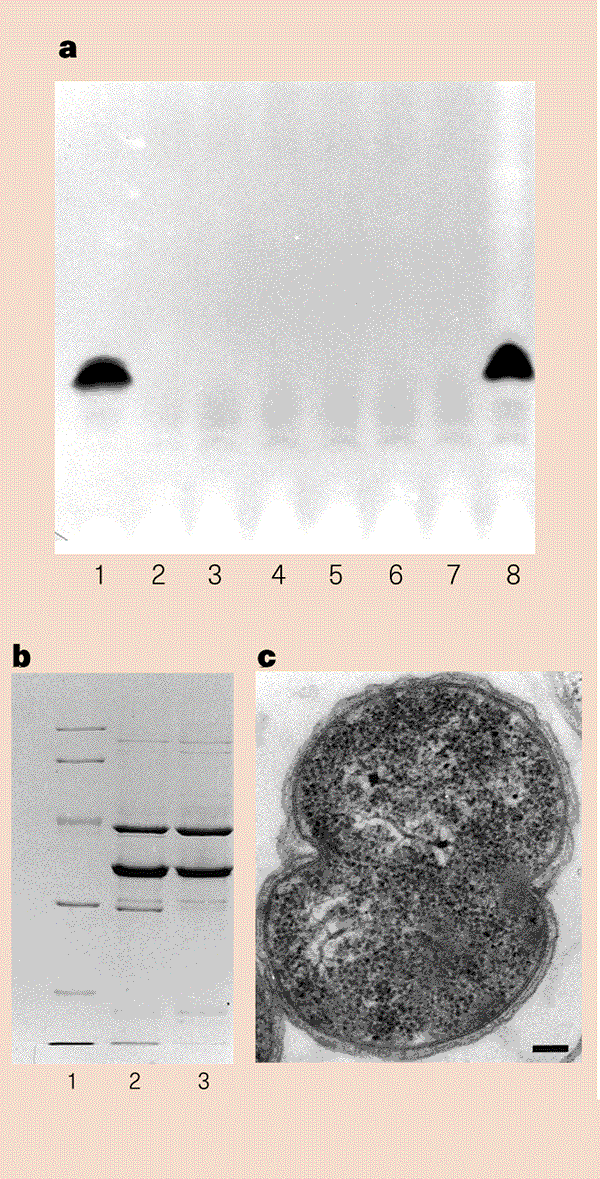Meningitis bacterium is viable without endotoxin (original) (raw)
The protein LpxA is responsible for adding the _O_-linked 3-OH fatty acid to UDP-_N_-acetylglucosamine, which is the first committed step in the lipid A biosynthesis pathway3,4. The E. coli and N. meningitidis LpxA proteins differ in their specificity, preferring 3-OH C14and 3-OH C12fatty acyl chains, respectively5,6.
We constructed a hybrid lpxA gene in which the meningococcal N-terminal part was replaced by the corresponding part of E. coli lpxA. Plasmid pHBK30, carrying this hybrid gene and an upstream kanamycin-resistance cassette, was used for allelic replacement of the wild-type lpxA gene on the chromosome of meningococcal strain H44/76. Lipopolysaccharide of the H44/76[pHBK30] mutant and the wild-type strain was compared by Tricine-SDS-PAGE followed by silver staining for carbohydrates (Fig. 1a). No LPS could be detected in the hybrid derivative by this method, even when higher amounts of cell lysates were loaded on the gel.
Figure 1: Analysis of_Neisseria meningitidis_ outer membrane.
a, Silver-stained Tricine-SDS-PAGE LPS gel of proteinase K-treated whole-cell lysates of H44/76 wild type (lanes 1 and 8) and six independent kanamycin-resistant transformants with pHBK30 (lanes 2-7). b, SDS-PAGE of outer membrane proteins from H44/76[pHBK30] (lane 2) and H44/76 wild type (lane 3); lane 1 contains relative molecular mass markers of 94K, 67K, 43K, 30K, 20.1K and 14.4K. c, Electron micrograph of a thin section of H44/76[pHBK30], showing normal appearance of the cell envelope with outer membrane, peptidoglycan layer within the periplasmic space, and inner membrane. Scale bar, 100 nm.
A panel of LPS and monoclonal antibodies specific for outer-membrane proteins (OMPs) was tested in a whole-cell enzyme-linked immunosorbent assay (ELISA)7,8. The mutant strain did not bind any of the LPS-specific antibodies (either immunotype-specific or broadly crossreactive), whereas the OMP-specific antibodies showed similar binding patterns for mutant and wild type. This apparent OMP similarity was confirmed when outer-membrane complexes (OMCs) of H44/76[pHBK30] and H44/76 were isolated by sarkosyl extraction and analysed by SDS-PAGE (Fig. 1b). Both strains show equal amounts of the class 1, 3 and 4 principal OMPs.
As LPS of H44/76[pHBK30] could not be detected, it was not clear whether it was present at all. Therefore, the mutant and wild-type strain were tested in a chromogenic Limulus (LAL) assay9 for endotoxin, using the QCL-1000 kit from BioWhittaker. The results of the LAL assay on cell suspensions showed no significant endotoxin activity for H44/76[pHBK30] over meningococcal medium (0.3 and 1.7 endotoxin units per millilitre, respectively), in contrast to 21.7×104 endotoxin units per millilitre for the wild type.
Although H44/76[pHBK30] is viable, it had a reduced growth rate. When grown overnight on GC agar plates, the mutant strain produced much smaller colonies. In liquid medium, the doubling time during exponential growth was about 50% longer than in the wild-type strain H44/76. The morphology of H44/76[pHBK30] and its parent strain was examined by electron microscopy of ultrathin sections (Fig. 1c). The ultrastructure of the outer membrane could be clearly discerned in the LPS-deficient mutant and was not visibly altered.
Strain H44/76[pHBK30] is viable and possesses an outer membrane, despite lacking detectable LPS. It seems likely that the hybrid lpxA gene is inactive, either because of disrupted transcription/translation in our construct, or otherwise because the hybrid protein produced lacks enzymatic activity. We constructed an _lpxA_-knockout mutant by inserting a kanamycin-resistance cassette into the _Bst_EII site located at position 293 in the lpxA gene of plasmid pLA21 (a pUC18 derivative with a 2.1 kilobase lpxD-fabZ-lpxA insert). The resulting plasmid pLAK33 was linearized and transformed to strain H44/76, with selection for kanamycin resistance. The resulting colonies showed the same growth properties as the H44/76[pHBK30] mutant. In whole-cell ELISA, the _lpxA_-knockout mutant did not bind any of the LPS-specific monoclonal antibodies.
The absence of LPS was further confirmed by gas chromatography/mass spectrometry analysis of fatty acids present in OMC preparations, which showed that the lipid A-specific 3-OH C12, whose addition to UDP-_N_-acetylglucosamine is catalysed by LpxA, was present only in trace amounts in the mutant. Also, no other _O_-linked 3-OH fatty acids in the range C10to C20could be detected. LPS biosynthesis could be restored in this knockout mutant by retransformation with wild-type lpxA, showing that the observed LPS deficiency must result from mutation in this gene only.
The availability of LPS-deficient mutants will allow new approaches to vaccine development against N. meningitidis10 and the closely related pathogen N. gonorrhoeae, or any other bacteria for which such mutants can be isolated. Using an lpxA mutant, it will be much easier to purify OMPs or other cell-surface components without contamination by endotoxin. Also, the role of LPS in outer-membrane-vesicle or whole-cell vaccines (for example as adjuvant11) can be investigated: it may be possible to substitute a less toxic compound. And at a more basic level, such mutants can be used for studying how LPS contributes to the structure and biogenesis of the outer membrane.
